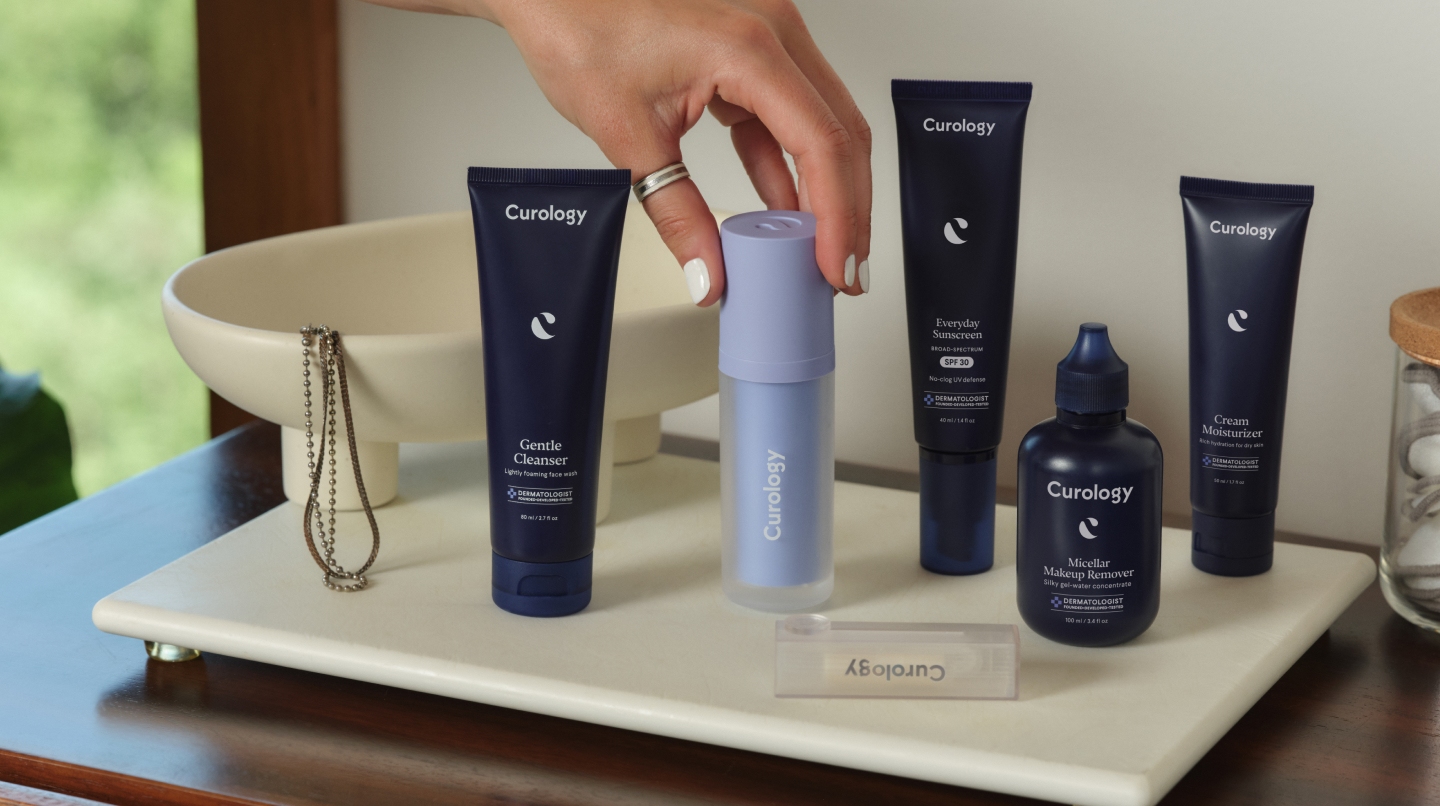How it works:
Share your skin goals and snap selfies
Your dermatology provider prescribes your formula
Apply nightly for happy, healthy skin
How it works:
How it works:
Share your skin goals and snap selfies
Your dermatology provider prescribes your formula
Apply nightly for happy, healthy skin
How it works:
Laundry detergent breakouts: What you need to know
This chore can have an unexpected, unpleasant side effect for some



Love it or hate it, laundry is an unavoidable chore. Regularly washing your clothes is essential for removing the dirt and bacteria that comes along with everyday wear, and there are countless detergents on the market today. Whether you’re trying to tackle a tough stain (we’re looking at you, chocolate and wine), care for delicate fabrics, or get your whites nice and bright, there’s likely something in the laundry aisle that will do the trick.
Unfortunately, clean clothes aren’t the only concern when picking a detergent. Skin rashes from detergent may happen if it contains an irritant or an ingredient you may be sensitive to. In addition to an allergy, face breakouts from detergent aren’t unheard of. Here we’ll tell you everything you need to know about laundry detergent breakouts and allergic reactions, including possible symptoms, potential contributing factors, and methods to treat and prevent them.
Getting to know your laundry detergent allergy rash
Ever get a red, itchy rash after you slip into your freshly washed sheets? It may be due to your detergent. Certain laundry detergents for clothing and household linens can cause breakouts or rashes for some people. When this occurs, it’s likely because a specific ingredient is acting as an allergen or irritant, leading to a condition known as allergic or irritant contact dermatitis.
Allergic contact dermatitis is an inflammatory skin disorder where your body’s immune system responds adversely to a perceived threat.¹ Triggering allergens vary widely, and their source can depend on personal habits, environment, hobbies, and more. Common causes of allergic contact dermatitis include preservatives, fragrances, nickel, textile chemicals, and more.² In rare cases, laundry detergents may also cause allergic contact dermatitis.³
Irritant contact dermatitis is the most common form of contact dermatitis. This inflammatory skin disorder occurs when your skin’s barrier is damaged by external agents or environmental factors (including detergent).⁴ It often affects the hands and is more common than allergic contact dermatitis.⁵
What do laundry detergent breakouts and rashes look like?
When your skin reacts to your laundry detergent, you might mistake the resulting irritation for eczema or another skin condition. Allergic and irritant contact dermatitis have similar symptoms that may appear on localized areas, such as the hands and face, or more widespread across the body. You may experience any of the following laundry detergent allergy symptoms:⁶,⁷
Dryness
Redness
Itching
Burning
Stinging
Swelling
Soreness

Contributing factors to laundry detergent breakouts and rashes
Dermatology providers are becoming more aware of laundry detergents’ irritant and allergenic potential, especially in formulas that use harsh surfactants and ingredients.⁸ The Journal of the American Academy of Dermatology reports that more than 80% of dermatologists recommend using dye- and perfume-free laundry detergents for patients with sensitive skin.⁹ Here are some of the ingredients that may cause allergic reactions or breakouts:
Residual detergent surfactants: Surfactants allow the detergent to mix with water and more effectively clean your clothes. Although they’re helpful, residual surfactants in your clothing after the wash may cause skin irritation.¹⁰
Fragrances: Fragrances are a common cause of allergic contact dermatitis.¹¹ If you think your scented laundry detergent is bothering your skin, look for an unscented formula designed for sensitive skin.
Alcohol: It’s less common, but alcohol is another ingredient that may cause contact dermatitis.¹²
Sodium lauryl sulfate (SLS) or sodium laureth sulfate (SLES): SLS and SLES are commonly thought to contribute to skin irritation when used in laundry detergents. A study compared skin reactions to SLS, SLES, and alkyl polyglucoside (APG)—a biodegradable ingredient derived from plant starch and the fatty alcohol from coconuts. It found a pronounced skin reaction to SLS and a milder skin reaction to SLES. In comparison, the skin reaction to APG, even at the highest concentration, was almost undetectable.¹³ Sodium lauryl sulfate is also known to clog pores, so we recommend checking your products for this ingredient!
Although it’s been thought in the past that laundry detergents containing enzymes may cause adverse skin reactions, detergents containing these ingredients actually have a history of safe use.¹⁴
How to treat rashes and breakouts from laundry detergent
If you’re having an uncomfortable reaction to your laundry detergent, there are steps you can take to avoid it. These reactions can appear in areas that are restricted by tight clothing, such as behind your knees and under your arms. Our dermatology providers recommend seeking professional help if you’re dealing with an allergy, but here are a few things you can do at home that may help:
Avoid the irritant: The primary treatment for irritant contact dermatitis is avoiding the ingredient that’s irritating you.¹⁵
Moisturize the affected area: Applying a barrier cream may help treat and prevent irritant contact dermatitis.¹⁶
Apply a cold compress: Hold a bag of ice or a cold, damp cloth to the affected area to help reduce swelling.
Take an oatmeal bath: Sometimes, a soothing bath is just what your skin needs. Add a cup of colloidal oatmeal to your bath and soak for half an hour to help soothe your skin and reduce irritation. Make sure that the water is lukewarm and not hot!
Use an antihistamine: If you’re allergic to your laundry detergent, consider taking an over-the-counter or prescription antihistamine medication. We recommend consulting your healthcare provider if needed.
Wear loose-fitting clothing: Swap your tight tops and pants for looser-fitting threads; it may help your skin irritation improve faster.
If you’re experiencing an allergic reaction, your medical provider may treat it in the following ways:¹⁷
Topical steroids: Topical steroids are typically prescribed when allergic contact dermatitis is confined to less than 20% of the body.
Oral corticosteroids: Oral corticosteroids are often used when allergic contact dermatitis covers more than 20% of the body.
How to help prevent laundry detergent breakouts
To prevent a rash from your laundry detergent, try to find a gentle, non-irritating product that works for your skin. This may take some trial and error. Our licensed dermatology providers recommend avoiding scented products, as these may be more likely to cause skin irritation. Go with gentle, unscented formulas designed for sensitive skin instead.
It may also help to avoid fabric softeners (including dryer sheets). Fabric softeners deposit a waxy residue onto fabrics. Although it hasn’t been proven, this may clog pores in acne-prone people.
Curology knows skincare
Curology was founded in 2014 by board-certified dermatologists. We’re a full-service skincare company offering affordable, effective products made with proven ingredients that treat acne, fine lines, wrinkles, hyperpigmentation, and rosacea.

Curology offers convenient and affordable personalized prescription formulas customized to your skin’s needs.* Sign up for a consultation from one of our in-house, licensed dermatology providers, who will provide expert guidance throughout your skincare journey. Getting started is as easy as taking a quick quiz and snapping a few selfies so we can get to know your skin better.
Our experts will take the guesswork out of your skincare routine and help you meet your skincare goals. Your custom treatment comes with any of our recommended skincare products, such as our cleanser, moisturizer, or sunscreen.
FAQs
When your skin reacts to your laundry detergent, you might mistake the resulting irritation for eczema or another skin condition. Allergic and irritant contact dermatitis have similar symptoms that may appear on localized areas, such as the hands and face, or more widespread across the body.
Our dermatology providers recommend seeking professional help if you’re dealing with an allergy, but here are a few things you can do at home that may help:
Avoid the irritant: The primary treatment for irritant contact dermatitis is avoiding the ingredient that’s irritating you.
Moisturize the affected area: Applying a barrier cream may help treat and prevent irritant contact dermatitis.
Apply a cold compress: Hold a bag of ice or a cold, damp cloth to the affected area to help reduce swelling.
Take an oatmeal bath: Sometimes, a soothing bath is just what your skin needs.
Use an antihistamine: If you’re allergic to your laundry detergent, consider taking an over-the-counter or prescription antihistamine medication.
Wear loose-fitting clothing: Swap your tight tops and pants for looser-fitting threads; it may help your skin irritation improve faster.
To prevent a rash from your laundry detergent, try to find a gentle, non-irritating product that works for your skin. This may take some trial and error. Our licensed dermatology providers recommend avoiding scented products, as these may be more likely to cause skin irritation. Go with gentle, unscented formulas designed for sensitive skin instead.
P.S. We did the homework so you don’t have to:
Mowad CM, et al. Allergic contact dermatitis: Patient diagnosis and evaluation. J Am Acad Dermatol. (June 2016).
Murphy, P.B., et al. Allergic Contact Dermatitis. StatPearls. (2022).
Belsito, D.V., et al. Allergic contact dermatitis to detergents: a multicenter study to assess prevalence. J Am Acad Dermatol. (2002).
Patel, K., Nixon, R. Irritant Contact Dermatitis - a Review. Curr Dermatol Rep. (2022).
Patel, K., Nixon, R. Irritant Contact Dermatitis - a Review. Curr Dermatol Rep. Ibid.
Murphy, P.B., et al. Allergic Contact Dermatitis. StatPearls. Ibid.
Patel, K., Nixon, R. Irritant Contact Dermatitis - a Review. Curr Dermatol Rep. Ibid.
A new approach to formulating a milder laundry detergent for patients with sensitive skin. Journal of the American Academy of Dermatology. (2017).
Clinical skin mildness evaluations of detergent residues on fabrics washed with two free liquid laundry detergents designed for sensitive skin predicted by analytical but not in vitro evaluations. American Academy of Dermatology. (2019).
Crawford, C., Zirwas, M.J. Laundry detergents and skin irritancy--a comprehensive review. Skinmed. (2014).
Cheng, J., Zug, K.A. Fragrance allergic contact dermatitis. Dermatitis. (2014).
Barbaud, A., et al. Eczéma de contact à l'alcool éthylique: comment réaliser les tests? [Contact dermatitis due to ethyl alcohol: how to perform patch tests?]. Ann Dermatol Venereol. (2000).
Löffler, H., Happle, R. Profile of irritant patch testing with detergents: sodium lauryl sulfate, sodium laureth sulfate and alkyl polyglucoside. Contact Dermatitis. (2003).
Basketter, D.A., et al. Enzymes, detergents and skin: facts and fantasies. Br J Dermatol. (2008).
Patel, K., Nixon, R. Irritant Contact Dermatitis - a Review. Curr Dermatol Rep. Ibid.
Patel, K., Nixon, R. Irritant Contact Dermatitis - a Review. Curr Dermatol Rep. Ibid.
Murphy, P.B., et al. Allergic Contact Dermatitis. StatPearls. Ibid.
Donna McIntyre is a board-certified nurse practitioner at Curology. She obtained her Master of Science in Nursing at MGH Institute of Health Professions in Boston, MA.
* Subject to consultation. Subscription is required. Results may vary.

Curology Team

Donna McIntyre, NP-BC
Related Articles
How to determine your skin type, according to expertsHow to remove makeup without makeup remover wipesThe complete guide to face cleansers for every skin typeDoes dermaplaning cause acne? Experts explain5 ways to calm sensitive skin, according to dermatology expertsPopular Articles
Ask Curology: Is my cold breaking me out?Slugging: The dermatologist-approved skincare hack going viral on TikTokTretinoin vs retinol: What’s the difference?How to create a self-care routine that actually sticksYour 2023 skincare horoscopeTry prescription skincare
Get routine essentials

Good skin days ahead
- Breakouts
- Redness
- Fine lines
- Dark spots
- Hair thinning